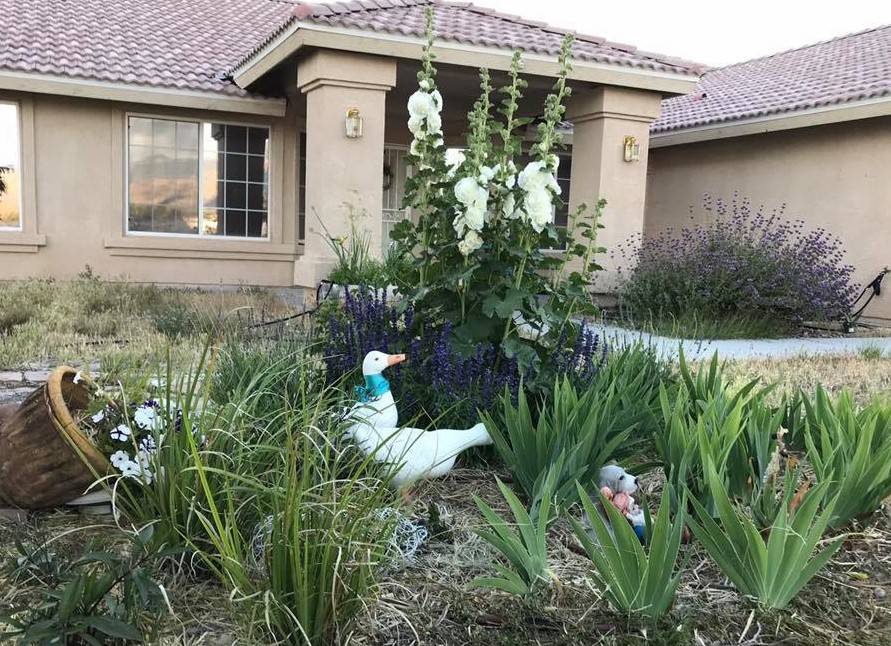IN SEASON: Creating a showy flowerbed display with hollyhocks as the main attraction
A few years ago, I was renting a small home in Las Vegas with a kitchen window that looked out over the backyard of several neighbors. It was tough economic times and most of those homes were in foreclosure. The backyards were a bit of an eyesore but there was one exception, a yard filled with a miniature meadow of tall stalks filled with colorful delicate flowers.
I would gaze in awe at the neighbor’s hollyhocks as I washed my dishes noticing the way they attracted the birds and other insects to the garden. This was my view for over three years as the flowers returned, season after season, though no one lived in the house during that time to tend them. After watching the seasons unfold, I was inspired to experiment with hollyhocks in my own garden.
I have also noticed hollyhocks growing along the washes and the side of the road near drainage ditches without any supplemental water. My observations have led me to the conclusion that hollyhocks are not only flowers of stunning beauty, but also hardy and drought tolerant. They are a worthy addition to any pollinator-friendly desert garden.
Planting and growing hollyhocks
Hollyhock seeds germinate best when temperatures are consistently between 60 to 70 degrees. This makes early fall the perfect time to direct sow hollyhock seeds into the garden. Some varieties of hollyhock flowers are biennial plants, which means that they have a two-year growing cycle and need two periods of cold weather to flower.
Hollyhocks can grow up to 9 feet high in clumps 1 foot or more in circumference. They should be planted at least 2 feet apart. Their height makes and them an excellent candidate for temporary privacy barriers along fencelines. In flower beds that follow the contour of a house, hollyhocks placed at the back will add a delightful vertical attraction to the design of the bed as well as attract birds and pollinators.
When getting ready to plant, choose a spot that receives full sun through most of the year. Hollyhocks do not transplant well, and direct sowing is recommended. Hollyhock seeds will germinate more quickly if you soak them for 4 to 6 hours before planting but if you are not in a rush the weatherizing processes of fall and winter are all that is needed to scarify the seeds for germination.
Hollyhocks enjoy fertile beds, but I have had success without highly amending the desert soil. I simply scratch the desert soil enough to make a 2 to 3-inch depression where I want to drop the seeds and fill the depression with quality compost or worm casings. I then drop the seeds into the compost. After that, I very lightly cover the seeds with straw mulch. Hollyhock seeds need light to germinate so be sure not to cover them too heavily.
After covering, I water with a gentle spray until the mulch and soil are fully damp. I continue watering daily for two weeks and then reduce to weekly watering. It would be helpful to mark the planting area with a stick or signage as you may not see seedlings emerge until spring.
As the soil warms the stalks will begin to spring up from the ground. They can reach their full height in three to four months depending on the variety. Some varieties of hollyhock will not flower the first year, or just put on a few blossoms. They will bloom throughout summer and into the fall. Removing the spent blossom heads, deadheading, will lead to more flowers as the stalk continues to grow. For tall and fully blooming hollyhocks, provide daily watering throughout the heat of summer.
As we head into fall and the weather cools, the stalks will begin to brown and dry. At this point, I cut the stalks back to the ground and cover with several inches of a lightweight mulch to overwinter. In the spring they will bloom once again for a second season even more brilliant than the first.
As the second season winds down, I collect the seeds from dried flowerheads for planting in other areas of my landscape or sharing with others. Hollyhocks will reseed itself reliably though and I see continued growth for several years to come as long as the area receives a fair amount of water.
In my garden, some of the greatest satisfaction that I have had as a gardener has been experimenting with hollyhocks to create a beautiful and showy centerpiece for flowerbeds. I miss the neighbor’s backyard that was my original inspiration, but I love looking out of my front window for a display of my own. I hope I have inspired you to do the same.
Terri Meehan is the Founder of Southern Nevada Gardening Association a regional group. She is a garden mentor and local farmer in Pahrump. Send questions or comments to her at sonvgarden@gmail.com
















